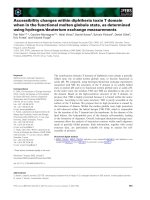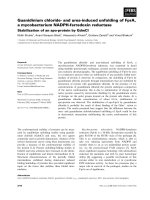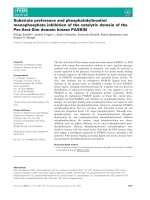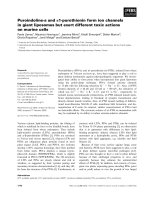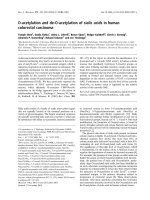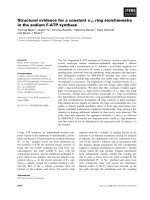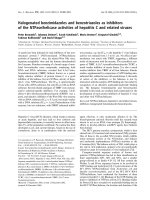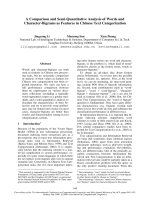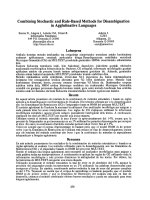Báo cáo khoa học: "KNOWLEDGE ORGANIZATION AND APPLICATION: BRIEF COMIIENTS OF PAPERS IN THE SESSION " potx
Bạn đang xem bản rút gọn của tài liệu. Xem và tải ngay bản đầy đủ của tài liệu tại đây (110.35 KB, 2 trang )
KNOI~LEDGE ORGANIZATION AND APPLICATION: BRIEF COMIIENTS ON PAPERS IN THE SESSION
Aravind K. Joshi
Department of Computer and Information Science
The Moore School
University of Pennsylvania, Philadelphia, PA 191O4
Comments:
My brief comments on the papers in this session are based
on the abstracts available to me and not on the complete
papers. Hence, it is quite possible that some of the
comments may turn out to be inappropriate or else they
have already been taken care of in the full texts. In a
couple of cases~ I had the benefit of reading some
earlier longer related reports, which were very helpful.
All the papers (except by Sangster) deal with either
knowledge representation, particular types of knowledge
to be represented, or how certain types of knowledge are
to be used.
Brackman describes a lattice-like structured inheritance
network (KLONE) as a language for explicit representation
of natural language conceptual information. Multiple
descriptions can be represented. How does the facility
differ from a similar one in KRL? Belief representations
appear to be only implicit. Quantification is handled
through a set of "structural descriptions." It is not
clear how negation is handled. The main application is
for the command and control of advanced graphics
manioulators through natural language. Is there an
implicit claim here that the KLONE representations are
suitable for both natural language concepts as well as
for those in the visual domain?
Sowa also presents a network like representation (con-
ceptual graphs). It is a representation that is
apparently based on some ideas of Hintikka on incomplete
but extensible models called surface models. Sowa also
uses some ideas of graph grammars. It is not clear how
multiple descriptions and beliefs can be represented in
this framework. Perhaps the detailed paper will clarify
some of these issues. This paper does not describe any
application.
Sangster's paper is not concerned, directly with knowledge
representation. It is concerned with complete and
partial matching procedures, especially for determining
whether a particular instance satisfies the criteria for
membership in a particular class. Matching procedures,
especially partial matching procedures, are highly rele-
vant to the use of any knowledge representation. Partial
matching procedures have received considerable attention
in the rule-based systems. This does not appear to be
the case for other representations.
Moore and Mann do not deal with knowledge representation
per se, but rather with the generation of natural lang-
uage texts from a given knowledge representation. They
are more concerned with the problem of generating a text
(which includes questions of ordering among sentences,
their scopes, etc.) which satisfies a goal held by the
system, describing a (cognitive) state of the reader.
The need for resorting to multi-sentence structures
arises from the fact that for achieving a desired state
of the reader, a single sentence may not be adequate.
~cDonald's work on generation appears to be relevant, but
it is not mentioned by the authors.
Burnstein is primarily concerned with knowledge about
(physical) objects and its role in the comprehension
process. The interest here is the need for a particular
type of knowledge rather than the representation scheme
itself, which he takes to be that of Schank. Knowledge
about objects, their normal uses, and the kinds of
actions they are normally involved in is necessary for
interjretation of sentences dealing with objects. In
sentence (1) John opened the bottle and poured the wine,
Burnstein's analysis indicates that the inference is dri-
ven largely by our knowledge about open bottles. In this
instance, this need not be the case. We have the same
situation in John took the bottle out of the refrioerator
and poured the w-Tne. The inference here is dependent on
knowing something about wine bottles and their normal
uses; knowledge of the fact that the bottle was open is
not necessary.
Given the normal reading of (1), (l') John opened the
bottle and ~ured the wine out of it will be judged as
re~u'n-~an t~-, be-Te't'~o'n'~f redundant material in (l') gives
(1). Deletion of redundant and recoverable material is a
device that language exploits. The recoverability here,
however, is dependent on the knowledge about the objects
and their normal uses.lf a non-normal reading of (1) is
intended (e.g., the wine bein 0 poured into the bottle)
then (l") John opened the bottle and poured the wine into
it is not felt redundant. This suggests that a prediction
that a normal reading is intended can be made (not, of
course, with complete certainty) by recognizing that we
are dealing with reduced forms. (Of course, context can
always override such a prediction.)
Some further questions are: Knowledge about objects is
essential for comprehension. The paper does not discuss,
however, how this knowledge and its particular represen-
tation helps in controlling the inferences in a uniform
manner. Is there any relationship of this work to the
common sense algorithms of Rieger?
Lebowitz is also concerned with a particular type of
knowledge rather than a representation scheme. Knowledge
about the reader's purpose is essential for comprehension.
The role played by the "interest" of the reader is also
explored. The application is for the comprehension of
newspaper stories. There is considerable work beyond the
indicated references in the analysis of goal-directed
discoursep but this has not been mentioned~
Finally, there are other issues which are important for
knowledge representation but which have been either left
out or only peripherally mentioned by some of the authors.
Some of these are as follows.
(i) A representation has to be adequate to support the
desired inference. But this is not enough. It is also
important to know how inferences are made (e.g., with
what ease or difficulty). The interaction of the nature
of a representation and the structure of the sentence or
discourse will make certain inferences go through more
easily than others.
(ii) Knowledge has to be updated. Again the nature of
the representation would make certain kinds of updates or
modifications easy and others difficult.
(iii) The previous issue also has a bearing on the
relationship between knowledge representation and know-
ledge acquisition. At some level, these two aspects
have to be viewed together.
31
